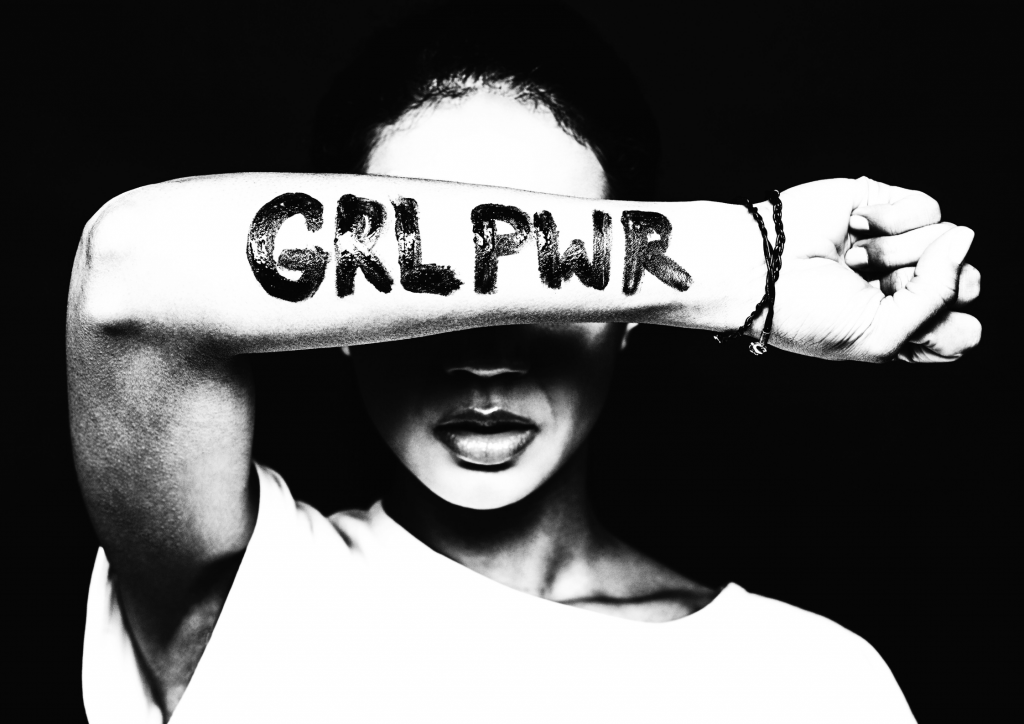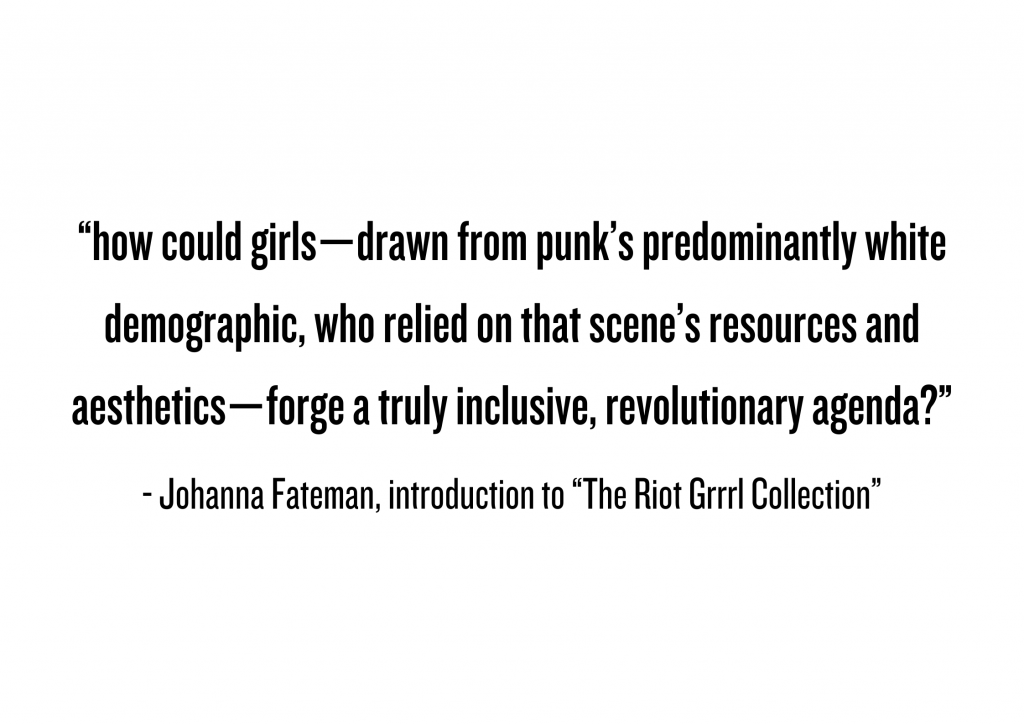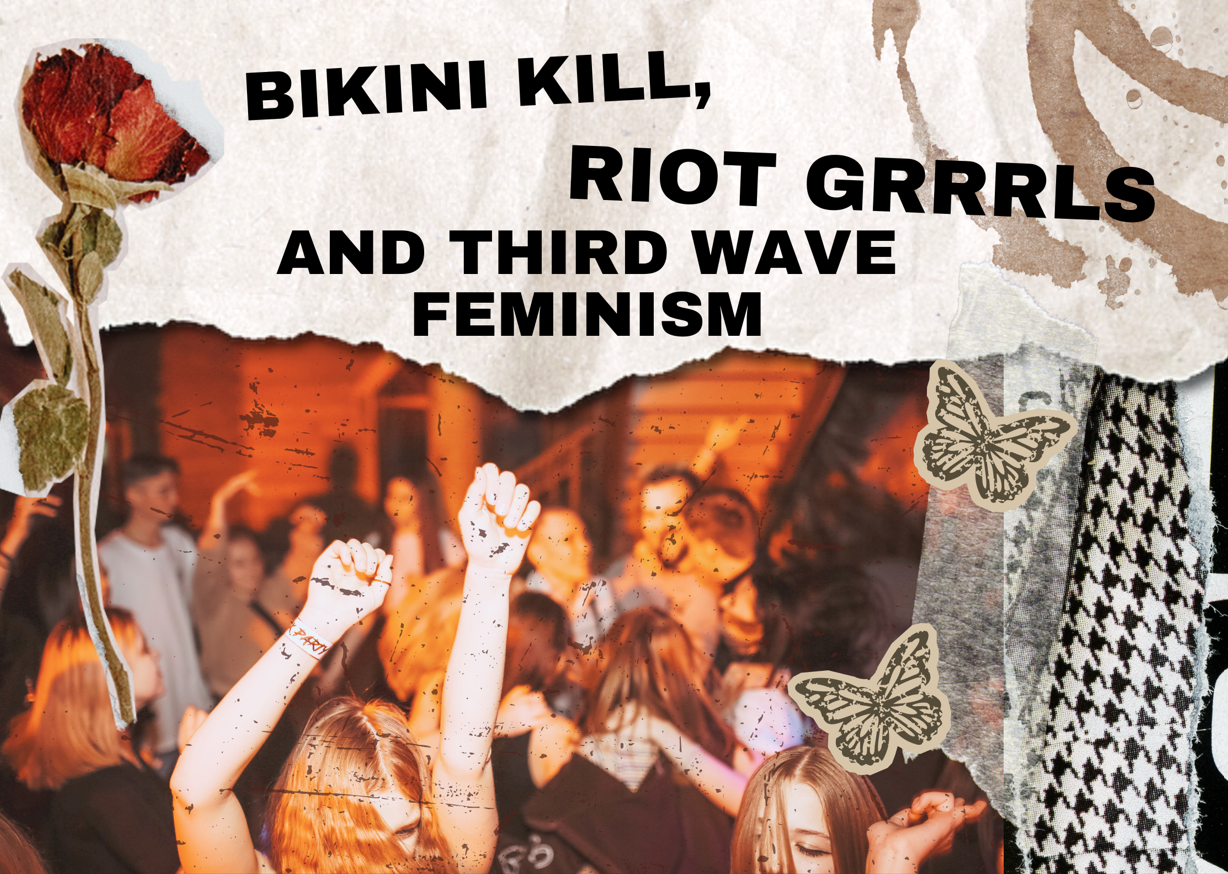Before the punk rock and the PR blackouts and Kathleen Hanna becoming the face of the revolution, there was the second wave of feminism. And before that, there was the first.
For the United States, it was founded at the 1848 Seneca Falls conference, in which female abolitionists organised for the first time on behalf of themselves, on behalf of eradicating slavery, and discovered their voices were unheard. This first wave rolled through into the 20th century, focused on citizenship and centred around the symbol of the vote. The suffragette movement rose up, found themselves losing, became militant and aggressive in response; they threw stones through windows, exploded post-boxes and starved themselves in prisons until tubes were forced down their noses to make them eat.
The suffragettes won. They got the vote. 1920 in the US, 1928 in the UK, as recent as 2015 in Saudi Arabia. The only country left where women can’t vote is Vatican City; only Cardinals can vote for the new pope; only men can be Cardinals.
The second wave appeared some forty years later, in the wake of the civil rights movement, of the peace movement, the free speech movement. Legally, women could vote, but they didn’t feel equal. So they marched for equality across the United States, until The Equal Rights Amendment was reintroduced in 1972. It passed but was never ratified by enough states on time to actually amend the Constitution. As of April 2023, a vote to remove the deadline and allow states to ratify the amendment now has also failed.
So, by the 90s, women were angry.

The third wave of feminism crashed into the mainstream as a response to the feeling discovered in colleges across America that feminism was dead or irrelevant. People were more apathetic to it than ever. By June, 1998, Time almost ran a cover with the headline IS FEMINISM DEAD?,and that was after Bikini Kill hurtled onto the scene, and Rebecca Walker, child of Alice Walker, daughter of the second wave, wrote her Ms. article, I Am the Third Wave, coining the term as a piece of the same history, but also announcing: we are different, we are doing something different.
What they were doing was loud. It was anti-patriarchal, it was angry, it was controversial and messy and undeniably punk. As stated in the Kathleen Hanna documentary, The Punk Singer, by feminist writer Jennifer Baumgardner: “The third wave cliché is a hot, angry, bisexual girl who is wearing a mini dress and combat boots. It’s like a lot of, I think, attempting to reconcile a lot of extremes that are in all of us.” It was brash and emotional; it was Hanna’s rage and physicality, unseen before by female performers. It was the way they dressed, the way they wore their hair, the way they held fast beside other women, insisting again and again that they would not let the media pit them against each other.
At a Bikini Kill gig, they would call for the girls to move up to the front. They said that men could be in the room, but they couldn’t dominate. Before them, mosh pits were dangerous places where men could break ribs with no consequences and women were regularly assaulted. Bikini Kill said No. Said, Girls to the front. Said, Women belong in this scene, so make a space for them.
Hanna’s college friend and artist, Tammy Rae Carland, said, “Somebody had to do Bikini Kill. Like, it had to happen or else we would’ve all starved to death, culturally.” And there they were, making music, making art, and shouting their feminist message loudly – a message that, in the ‘90s, was about violence against women, rape, sexual liberation and female self-empowerment. It was also, importantly, encouraging their audience to stand up and know their own power; and whether that was making sure they were voting or, more commonly, making protest art in girl bands, they fed the message into all of their lyrics.
In their 1991 song Double Dare Ya from their album, Revolution Girl Style Now!, Bikini Kill sings “You’re a big girl now/You’ve got no reason not to fight/You’ve got to know what they are/’Fore you can stand up for your rights/Rights, rights?/You do have rights”.
The revolution didn’t just exist in Bikini Kill’s songs, of course, but through their zines.

Zines (short for “magazine”) were often handmade, taking on a number of media to splash across a message, be it political or not. They were art projects, poetry, essays, collages, song lyrics, photographs. They took on the form of fanzines, dedicated to bands or books or TV shows, or they could be entirely original thoughts: manifestos or journals-turn-public masterpieces. While zines were already being used in punk culture, they flourished in this woman-centric space, following the legacy of self-published feminist writing that allowed women to circulate ideas that could not get otherwise published.
Last year, for Women’s History Month, we traced the origins of the girl power movement through the Spice Girls and back to Bikini Kill’s self-titled zine. It is there that girl power began; that the riot grrrl movement began, with Hanna’s Riot Grrrl Manifesto. They’d made a band, the four of them: Kathleen Hanna, Kathi Wilcox, Tobi Vail and Billy Karren. They’d made music, even though Wilcox didn’t know how to play a single instrument when she joined – “What everyone said about us was that we can’t play our instruments. And we said… and?” – and Vail was already writing the zine Jigsaw when they all met.
Then they wrote Bikini Kill and Hanna wrote the Manifesto, Vail coining “grrrl” – choosing “girl” to focus on childhood, when people typically have the strongest self-esteem and belief in themselves; using a growling “r” as a way to take back use of “girl” as a derogatory term – and the group refusing to define what a riot grrrl was beyond supportive to other women and empowered in herself, so anyone could take it on and make it fit.
Riot grrrl zines popped up everywhere after that. Women felt like there wasn’t a space for them in the often exclusionary, male-dominated punk culture of the time – but here was a space made just for them. And Bikini Kill were not alone, of course (just my personal favourite). Bratmobile, co-creators of the riot grrrl subculture, was founded the year after, having published their own zine, Girl Germs, in 1990. Heavens to Betsy, Excuse 17, Slant 6 and several more were also formed in same punk scene of Olympia, Washington State, in the same handful of boisterous, grrrlish years. There was also Emily’s Sassy Lime, made up of teenage American girls with Asian-immigrant backgrounds; Huggy Bear and Skinned Teen in the UK.
It was not a utopian subculture, however. I can’t get away with writing about the riot grrrl movement without acknowledging its pitfalls.
Despite subjects like class and race being talking points of riot grrrls, and even being featured as talks at conventions and events, they reportedly always fell short. In an infamous 1992 Newsweek article, the scene was referred to as predominantly “young, white, suburban and middle class” – which Le Tigre’s Johanna Fateman confirmed in the introduction to The Riot Grrrl Collection, Lisa Darms’ 2013 assemblage of zines, posters and printed matter from the riot grrrl era. Fateman wrote that it wasn’t an entirely white culture, but “how could girls—drawn from punk’s predominantly white demographic, who relied on that scene’s resources and aesthetics—forge a truly inclusive, revolutionary agenda?”

Women of colour who tried involving themselves in punk and riot grrrl expressed that they couldn’t. That women of colour were an afterthought, that amongst the far-reaching archives of riot grrrl zines that made up The Riot Grrrl Collection, there is only one Black riot grrrl – only one archived Black experience in the scene: Ramdasha Bikceem, whose zine, GUNK, shared thoughts on punk, skateboarding, feminism and racism.
In Vice’s Alternatives to Alternatives: the Black Grrrls Riot Ignored, Black women who were unable to find community and kinship amongst the whiteness of the riot grrrls are interviewed, revealing the subculture they crafted for themselves as sista grrrls.
Sista grrrl, as told by Catalyst, was the feminist mother of Afro-punk. Made by Black women for Black women, four Black punk musicians met up and created a space in which they were not an afterthought – they were the only thought. The central thought.
It was there that they were able to experience the empowerment that the white, middle-class girl was able to find within riot grrrl, that they had been excluded from feeling.
Riot grrrl was a blaze that began to dim by the mid-90s. Although there are still whispers of it today, the PR blackouts that Bikini Kill started when the mass media continuously misrepresented their message, allowed them both to control the narrative in a move of ideological power, but also inhibited the message from actually getting out there. Almost all of the riot grrrl bands had split by ’98, although most of the musicians involved are still making politically-charged music today. Kathleen Hanna fronts the Julie Ruin after spending a few years on her electronic rock group, Le Tigre; Bikini Kill is touring in 2024.
As a subculture, it was vibrant, important. The tenants of riot grrrl-ism still hold true to this day. The need to be loud, to be not just in the room but at the front of it, to be commanding of time and attention, still hold water in today’s feminist climate.
Since 2012, we’ve been in the fourth wave of feminism; a wave crashing over the rocks of #MeToo, of Amber Heard vs Johnny Depp, of mass Women’s Marches in the face of mass rollbacks to women’s rights globally. The fourth wave is not focused on the third’s sexual liberation, but on intersectionality and women’s empowerment in the age of the internet.
Since the recent surge of Artificial Intelligence began, AI deepfakes of female nudity services have skyrocketed. Over 30,000 non-consensual intimate images were generated in 2023.
Riot grrrls would have something to say about this. We should, too.
If you’re interested in learning more about riot grrrls, here’s your time-honoured Further Reading:
- Alternatives to Alternatives: the Black Grrrls Riot Ignored (2015)
- Evolution of a Race Riot #1 (zine, 1997)
- The POC Zine Project
- Why I Was Never a Riot Grrrl (2013)
- Riot Grrrl Manifesto (1991)
- Sista Grrrl: The Feminist Mother of Afro-punk (2021)
- diary of a sista grrrl (zine, 2022-23)
- The Asian riot grrrls who changed my life (2020)
- Girls to the Front, Sara Marcus (book, 2010)
By Bethany Climpson, Sustainability Engagement Assistant
 Sustainability
Sustainability Bethany Climpson
Bethany Climpson 1443
1443


